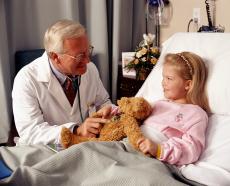

10/23/2015 05:51 PM EDT
Related MedlinePlus Pages: Cancer in Children, End of Life Issues
MEDICAL ENCYCLOPEDIA
- After chemotherapy - discharge
- Children's cancer centers
- Eating extra calories when you are sick - children
- Getting support when your child has cancer
- Helping your child understand a cancer diagnosis
- How childhood cancers are different from adult cancers
- Rhabdomyosarcoma
- Treatment for childhood cancer -- long-term risks
- When your child's treatment stops working
National Institutes of Health
NIH MedlinePlus Magazine
Cancer begins in the cells, which are the building blocks of your body. Normally, new cells form as you need them, replacing old cells that die. Sometimes, this process goes wrong. New cells form when you don't need them, and old cells don't die when they should. The extra cells can form a tumor. Benign tumors aren't cancer while malignant ones are. Malignant tumor cells can invade nearby tissues or break away and spread to other parts of the body.
Children can get cancer in the same parts of the body as adults, but there are differences. Childhood cancers can occur suddenly, without early symptoms, and have a high rate of cure. The most common children's cancer is leukemia. Other cancers that affect children include brain tumors,lymphoma, and soft tissue sarcoma. Symptoms and treatment depend on the cancer type and how advanced it is. Treatment may include surgery, radiation and/or chemotherapy.
NIH: National Cancer Institute
- Childhood Brain Tumor Survivors May Have Memory Troubles (10/02/2015, HealthDay)
- Childhood Cancer Devastates Family Finances, Too (09/23/2015, HealthDay)
- Removing All Visible Cancer Is Key to Treating Aggressive Brain Tumors (09/14/2015, HealthDay)
- More News on Cancer in Children
- How Are Childhood Cancers Found? (American Cancer Society)
- Stages of Childhood Extracranial Germ Cell Tumors (National Cancer Institute)Available in Spanish
- Tests and Procedures (CureSearch for Children's Cancer)
- Bone Marrow or Blood Stem Cell Transplants in Children With Severe Forms of Autoimmune Disorders or Certain Types of Cancer (Agency for Healthcare Research and Quality)Available in Spanish
- Chemotherapy (For Parents) (Nemours Foundation)Available in Spanish
- Immunotherapy (For Parents) (Nemours Foundation)
- Radiation Therapy (For Parents) (Nemours Foundation)Available in Spanish
- Side Effects of Chemotherapy and Radiation (For Parents) (Nemours Foundation)Available in Spanish
- Steroids for Treating Cancer (For Parents) (Nemours Foundation)Available in Spanish
- Treatment Option Overview (Unusual Cancers of Childhood)
 (National Cancer Institute)Available in Spanish
(National Cancer Institute)Available in Spanish - Treatment Options for Childhood Extracranial Germ Cell Tumors (National Cancer Institute)
- Nutrition for Children with Cancer (American Cancer Society)Available in Spanish
- Nutritional Needs for Kids with Cancer (Nemours Foundation)
- Anxiety Around Medical Procedures (CureSearch for Children's Cancer)
- Effects of Cancer Treatment on Fertility (For Parents) (Nemours Foundation)Available in Spanish
- Late Effects of Treatment for Childhood Cancer (PDQ)
 (National Cancer Institute)Available in Spanish
(National Cancer Institute)Available in Spanish - Relapse or Recurrence (CureSearch for Children's Cancer)
- General Information about Childhood Extracranial Germ Cell Tumors
 (National Cancer Institute)
(National Cancer Institute) - Other Rare Unusual Cancers of Childhood
 (National Cancer Institute)Available in Spanish
(National Cancer Institute)Available in Spanish - Unusual Cancers of the Abdomen
 (National Cancer Institute)Available in Spanish
(National Cancer Institute)Available in Spanish - Unusual Cancers of the Chest
 (National Cancer Institute)Available in Spanish
(National Cancer Institute)Available in Spanish - Unusual Cancers of the Head and Neck
 (National Cancer Institute)Available in Spanish
(National Cancer Institute)Available in Spanish - Unusual Cancers of the Reproductive and Urinary Systems
 (National Cancer Institute)Available in Spanish
(National Cancer Institute)Available in Spanish - What Are the Most Common Types of Childhood Cancers? (American Cancer Society)
- Clinical Perspectives: 7-Year-Old Girl Has 6 Organs Removed and Retransplanted
 (OR-Live) - Morgan Stanley Children's Hospital of New York-Presbyterian, New York, NY, 6/17/2009
(OR-Live) - Morgan Stanley Children's Hospital of New York-Presbyterian, New York, NY, 6/17/2009
- Snapshot of Adolescent and Young Adult Cancer
 (National Cancer Institute)Available in Spanish
(National Cancer Institute)Available in Spanish - Snapshot of Pediatric Cancers
 (National Cancer Institute)Available in Spanish
(National Cancer Institute)Available in Spanish
- Dictionary of Cancer Terms
 (National Cancer Institute)Available in Spanish
(National Cancer Institute)Available in Spanish
- American Cancer Society
- Cancer Genetics Services Directory
 (National Cancer Institute)
(National Cancer Institute) - Find a Cancer Doctor (American Society of Clinical Oncology)
- National Cancer Institute
 Available in Spanish
Available in Spanish - NCI Designated Cancer Centers
 (National Cancer Institute)Available in Spanish
(National Cancer Institute)Available in Spanish - Organizations That Offer Support Services
 (National Cancer Institute)
(National Cancer Institute)
- Chemotherapy (Nemours Foundation)Available in Spanish
- Some Kinds of Cancer Kids Get (Nemours Foundation)Available in Spanish
- What Is Cancer? (Nemours Foundation)Available in Spanish
- Adolescents and Young Adults with Cancer
 (National Cancer Institute)
(National Cancer Institute) - Cancer Basics (Nemours Foundation)Available in Spanish
- Chemotherapy (Nemours Foundation)Available in Spanish
- Dealing with Cancer (Nemours Foundation)Available in Spanish
- Radiation Therapy (Nemours Foundation)Available in Spanish
- Types of Cancer Teens Get (Nemours Foundation)Available in Spanish
- After chemotherapy - discharge Available in Spanish
- Children's cancer centers
- Eating extra calories when you are sick - children Available in Spanish
- Getting support when your child has cancer
- Helping your child understand a cancer diagnosis
- How childhood cancers are different from adult cancers Available in Spanish
- Treatment for childhood cancer -- long-term risks Available in Spanish
- Understanding Chemotherapy

 (National Cancer Institute) - PDFAvailable in Spanish
(National Cancer Institute) - PDFAvailable in Spanish - When your child's treatment stops working Available in Spanish





















.png)











No hay comentarios:
Publicar un comentario